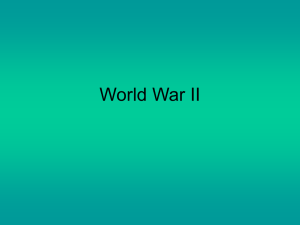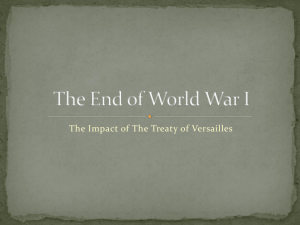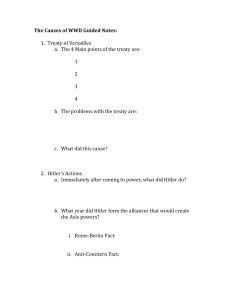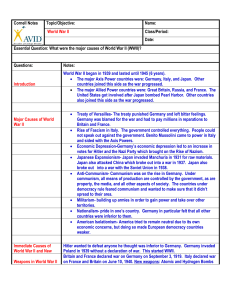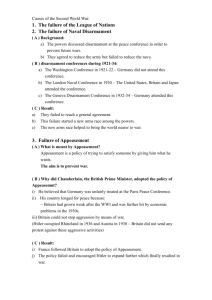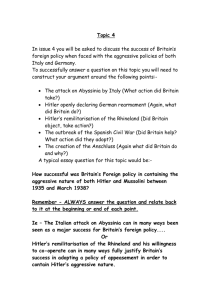can be found here.
advertisement
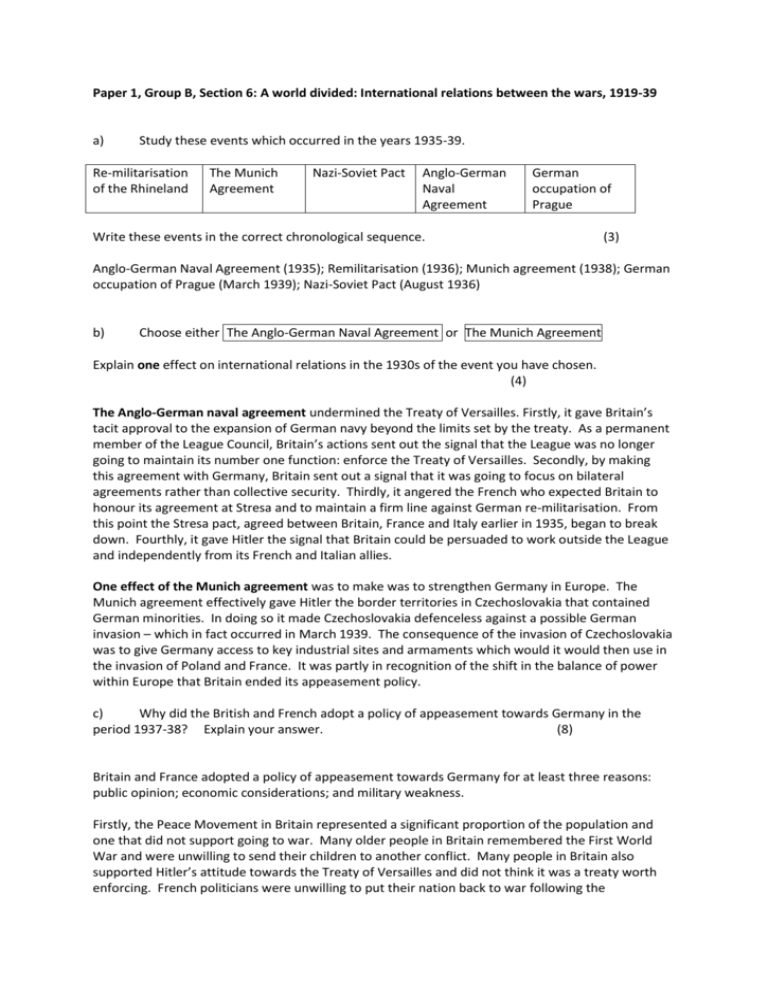
Paper 1, Group B, Section 6: A world divided: International relations between the wars, 1919-39 a) Study these events which occurred in the years 1935-39. Re-militarisation of the Rhineland The Munich Agreement Nazi-Soviet Pact Anglo-German Naval Agreement German occupation of Prague Write these events in the correct chronological sequence. (3) Anglo-German Naval Agreement (1935); Remilitarisation (1936); Munich agreement (1938); German occupation of Prague (March 1939); Nazi-Soviet Pact (August 1936) b) Choose either The Anglo-German Naval Agreement or The Munich Agreement Explain one effect on international relations in the 1930s of the event you have chosen. (4) The Anglo-German naval agreement undermined the Treaty of Versailles. Firstly, it gave Britain’s tacit approval to the expansion of German navy beyond the limits set by the treaty. As a permanent member of the League Council, Britain’s actions sent out the signal that the League was no longer going to maintain its number one function: enforce the Treaty of Versailles. Secondly, by making this agreement with Germany, Britain sent out a signal that it was going to focus on bilateral agreements rather than collective security. Thirdly, it angered the French who expected Britain to honour its agreement at Stresa and to maintain a firm line against German re-militarisation. From this point the Stresa pact, agreed between Britain, France and Italy earlier in 1935, began to break down. Fourthly, it gave Hitler the signal that Britain could be persuaded to work outside the League and independently from its French and Italian allies. One effect of the Munich agreement was to make was to strengthen Germany in Europe. The Munich agreement effectively gave Hitler the border territories in Czechoslovakia that contained German minorities. In doing so it made Czechoslovakia defenceless against a possible German invasion – which in fact occurred in March 1939. The consequence of the invasion of Czechoslovakia was to give Germany access to key industrial sites and armaments which would it would then use in the invasion of Poland and France. It was partly in recognition of the shift in the balance of power within Europe that Britain ended its appeasement policy. c) Why did the British and French adopt a policy of appeasement towards Germany in the period 1937-38? Explain your answer. (8) Britain and France adopted a policy of appeasement towards Germany for at least three reasons: public opinion; economic considerations; and military weakness. Firstly, the Peace Movement in Britain represented a significant proportion of the population and one that did not support going to war. Many older people in Britain remembered the First World War and were unwilling to send their children to another conflict. Many people in Britain also supported Hitler’s attitude towards the Treaty of Versailles and did not think it was a treaty worth enforcing. French politicians were unwilling to put their nation back to war following the devastation caused during WWI. They built a defensive fortification known as the Maginot line during this time rather than risk provoking Germany. Finally, many politicians in Britain feared the Soviet Union more than they feared Germany. Secondly, the Wall Street Crash of 1929 and the Great Depression that followed meant that neither Britain nor France could afford to fight a war abroad. An arms race at this stage could only have been achieved at a cost to public spending and during this time of severe austerity, politicians were unwilling to support an expensive arms race. Thirdly, Britain and France were militarily too weak to fight a war before 1939. Germany had been re-arming, firstly in secret since 1933 and then openly since 1935. Any conflict over central European territories would have involved Britain in an overseas war for which it was ill-equipped and in which Germany held enormous advantage. All three reasons strengthened public opinion against fighting a war against Germany. The austerity at home and the cost of fighting a conflict abroad and the re-militarisation that would have to follow were as significant in British and French motives for appeasement as anticipation of the potential loss of life. d) Study the source below and then answer the question that follows. Source: From a modern History textbook. There was no doubt that Hitler was always determined to challenge the Treaty of Versailles. His policies show an ever increasing boldness of action, although at first he was necessarily cautious. His approach was able to take advantage of weaknesses among his opponents, but after 1936 he was able to take the initiative much more. This culminated in the aggressive stance towards Poland in 1939. Use the source, and your own knowledge, to explain the development of Hitler’s foreign policy in the 1930s. (10) As the source suggests, at first Hitler’s approach was cautious. He secretly began re-armament in 1933 and only when emboldened by Mussolini’s actions in Abyssinia did he announce conscription and remilitarisation of the Rhineland the following year. Britain began appeasement with the signing of the Anglo-German Naval Agreement and did nothing to stop Germany announcing conscription and then remilitarising the Rhineland in 1936. Having tested Britain and France’s resolve and got away with it, Hitler openly flouted the Treaty in 1938 with Anschluss. As the source suggests, Hitler was able to take advantage of weaknesses among his opponents. As Germany made demands for the Sudetenland in 1938 Britain felt unable to intervene in ‘a far off country’ because of the costs involved and the advantage Germany would have. Britain was too military weak to adopt any other policy so did nothing to resist and Hitler. This led Hitler to become more aggressive still. When Britain and France failed to stop Germany taking the rest of Czechoslovakia in March 1939, Hitler took an ‘aggressive stance towards Poland in 1939’. Britain’s failure to act on Czechoslovakia therefore meant that Hitler was confident that Britain would not act to defend Polish interests. Overall, Hitler’s foreign policy began cautiously but his ability to challenge the Treaty led to him becoming increasingly aggressive, particularly as Britain, France and the League of Nations failed to stand up to his aggression. He began by leaving the League, testing the Treaty before flouting its terms by 1938. In completing Anschluss with Austria, Hitler had completed his revisions of the Treaty of Versailles. Consequently, with the occupation of Prague and the invasion of Poland he had moved beyond the Treaty to another goal: Lebensraum.
